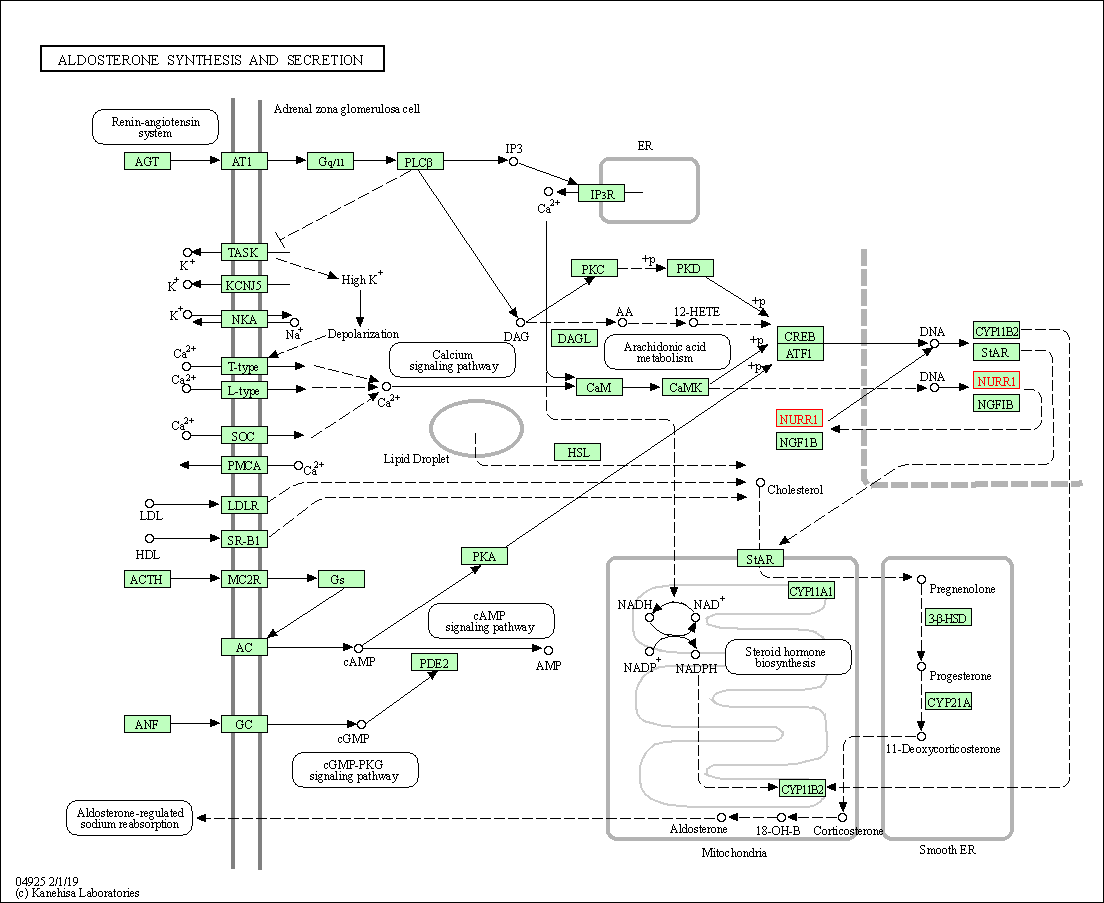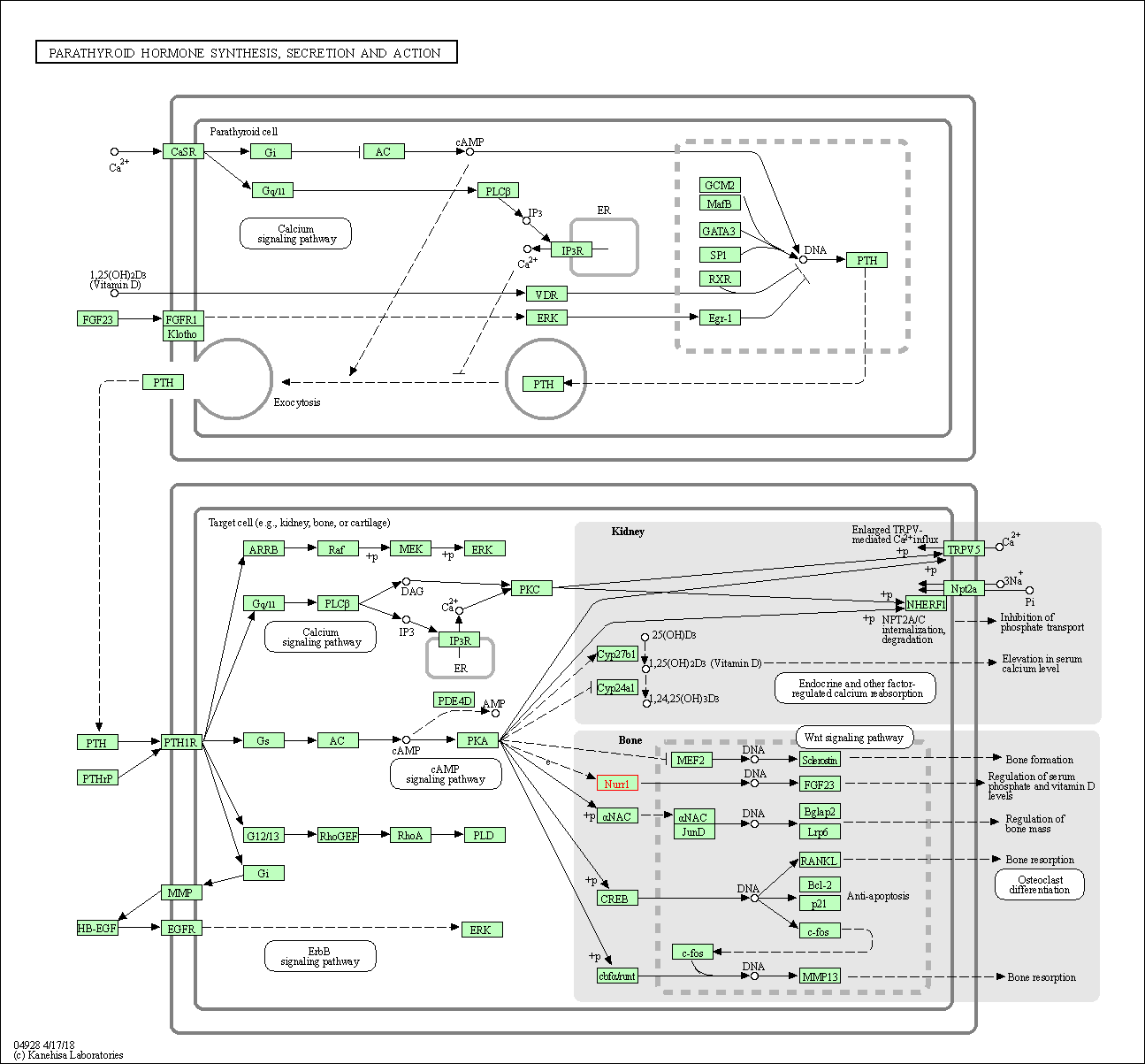Target Information
| Target General Information | Top | |||||
|---|---|---|---|---|---|---|
| Target ID |
T67163
(Former ID: TTDR00554)
|
|||||
| Target Name |
Orphan nuclear receptor NURR1 (NR4A2)
|
|||||
| Synonyms |
Transcriptionally-inducible nuclear receptor; Transcriptionally inducible nuclear receptor; TINUR; Nuclear receptor subfamily 4 group A member 2; NURR1; NOT; Immediate-early response protein NOT
Click to Show/Hide
|
|||||
| Gene Name |
NR4A2
|
|||||
| Target Type |
Literature-reported target
|
[1] | ||||
| Function |
It is crucial for expression of a set of genes such as SLC6A3, SLC18A2, TH and DRD2 which are essential for development of mdDA neurons. Transcriptional regulator which is important for the differentiation and maintenance of meso-diencephalic dopaminergic (mdDA) neurons during development.
Click to Show/Hide
|
|||||
| BioChemical Class |
Nuclear hormone receptor
|
|||||
| UniProt ID | ||||||
| Sequence |
MPCVQAQYGSSPQGASPASQSYSYHSSGEYSSDFLTPEFVKFSMDLTNTEITATTSLPSF
STFMDNYSTGYDVKPPCLYQMPLSGQQSSIKVEDIQMHNYQQHSHLPPQSEEMMPHSGSV YYKPSSPPTPTTPGFQVQHSPMWDDPGSLHNFHQNYVATTHMIEQRKTPVSRLSLFSFKQ SPPGTPVSSCQMRFDGPLHVPMNPEPAGSHHVVDGQTFAVPNPIRKPASMGFPGLQIGHA SQLLDTQVPSPPSRGSPSNEGLCAVCGDNAACQHYGVRTCEGCKGFFKRTVQKNAKYVCL ANKNCPVDKRRRNRCQYCRFQKCLAVGMVKEVVRTDSLKGRRGRLPSKPKSPQEPSPPSP PVSLISALVRAHVDSNPAMTSLDYSRFQANPDYQMSGDDTQHIQQFYDLLTGSMEIIRGW AEKIPGFADLPKADQDLLFESAFLELFVLRLAYRSNPVEGKLIFCNGVVLHRLQCVRGFG EWIDSIVEFSSNLQNMNIDISAFSCIAALAMVTERHGLKEPKRVEELQNKIVNCLKDHVT FNNGGLNRPNYLSKLLGKLPELRTLCTQGLQRIFYLKLEDLVPPPAIIDKLFLDTLPF Click to Show/Hide
|
|||||
| 3D Structure | Click to Show 3D Structure of This Target | AlphaFold | ||||
| HIT2.0 ID | T81LOK | |||||
| Cell-based Target Expression Variations | Top | |||||
|---|---|---|---|---|---|---|
| Cell-based Target Expression Variations | ||||||
| Drug Binding Sites of Target | Top | |||||
|---|---|---|---|---|---|---|
| Ligand Name: Cysteinesulfonic Acid | Ligand Info | |||||
| Structure Description | Nurr1 Covalently Modified by a Dopamine Metabolite | PDB:6DDA | ||||
| Method | X-ray diffraction | Resolution | 3.20 Å | Mutation | No | [2] |
| PDB Sequence |
SLISALVRAH
372 VDSNPAMTSL382 DYSRFQANPD392 DTQHIQQFYD408 LLTGSMEIIR418 GWAEKIPGFA 428 DLPKADQDLL438 FESAFLELFV448 LRLAYRSNPV458 EGKLIFNGVV469 LHRLQCVRGF 479 GEWIDSIVEF489 SSNLQNMNID499 ISAFSCIAAL509 AMVTERHGLK519 EPKRVEELQN 529 KIVNCLKDHV539 TFRPNYLSKL555 LGKLPELRTL565 CTQGLQRIFY575 LKLEDLVPPP 585 AIIDKLFLDT595 LPF
|
|||||
|
|
||||||
| Ligand Name: Prostaglandin A2 | Ligand Info | |||||
| Structure Description | Crystal structure of PG-bound Nurr1-LBD | PDB:5YD6 | ||||
| Method | X-ray diffraction | Resolution | 2.34 Å | Mutation | No | [3] |
| PDB Sequence |
VSLISALVRA
371 HVDSNPAMTS381 LDYSRFQANP391 DDTQHIQQFY407 DLLTGSMEII417 RGWAEKIPGF 427 ADLPKADQDL437 LFESAFLELF447 VLRLAYRSNP457 VEGKLIFCNG467 VVLHRLQCVR 477 GFGEWIDSIV487 EFSSNLQNMN497 IDISAFSCIA507 ALAMVTERHG517 LKEPKRVEEL 527 QNKIVNCLKD537 HVTFPNYLSK554 LLGKLPELRT564 LCTQGLQRIF574 YLKLEDLVPP 584 PAIIDKLFLD594 TLPF
|
|||||
|
|
||||||
| Click to View More Binding Site Information of This Target with Different Ligands | ||||||
| Different Human System Profiles of Target | Top |
|---|---|
|
Human Similarity Proteins
of target is determined by comparing the sequence similarity of all human proteins with the target based on BLAST. The similarity proteins for a target are defined as the proteins with E-value < 0.005 and outside the protein families of the target.
A target that has fewer human similarity proteins outside its family is commonly regarded to possess a greater capacity to avoid undesired interactions and thus increase the possibility of finding successful drugs
(Brief Bioinform, 21: 649-662, 2020).
Human Pathway Affiliation
of target is determined by the life-essential pathways provided on KEGG database. The target-affiliated pathways were defined based on the following two criteria (a) the pathways of the studied target should be life-essential for both healthy individuals and patients, and (b) the studied target should occupy an upstream position in the pathways and therefore had the ability to regulate biological function.
Targets involved in a fewer pathways have greater likelihood to be successfully developed, while those associated with more human pathways increase the chance of undesirable interferences with other human processes
(Pharmacol Rev, 58: 259-279, 2006).
Biological Network Descriptors
of target is determined based on a human protein-protein interactions (PPI) network consisting of 9,309 proteins and 52,713 PPIs, which were with a high confidence score of ≥ 0.95 collected from STRING database.
The network properties of targets based on protein-protein interactions (PPIs) have been widely adopted for the assessment of target’s druggability. Proteins with high node degree tend to have a high impact on network function through multiple interactions, while proteins with high betweenness centrality are regarded to be central for communication in interaction networks and regulate the flow of signaling information
(Front Pharmacol, 9, 1245, 2018;
Curr Opin Struct Biol. 44:134-142, 2017).
Human Similarity Proteins
Human Pathway Affiliation
Biological Network Descriptors
|
|
|
There is no similarity protein (E value < 0.005) for this target
|
| KEGG Pathway | Pathway ID | Affiliated Target | Pathway Map |
|---|---|---|---|
| Aldosterone synthesis and secretion | hsa04925 | Affiliated Target |

|
| Class: Organismal Systems => Endocrine system | Pathway Hierarchy | ||
| Parathyroid hormone synthesis, secretion and action | hsa04928 | Affiliated Target |

|
| Class: Organismal Systems => Endocrine system | Pathway Hierarchy | ||
| Degree | 1 | Degree centrality | 1.07E-04 | Betweenness centrality | 0.00E+00 |
|---|---|---|---|---|---|
| Closeness centrality | 1.78E-01 | Radiality | 1.29E+01 | Clustering coefficient | 0.00E+00 |
| Neighborhood connectivity | 1.40E+01 | Topological coefficient | 1.00E+00 | Eccentricity | 13 |
| Download | Click to Download the Full PPI Network of This Target | ||||
| Chemical Structure based Activity Landscape of Target | Top |
|---|---|
| Target Regulators | Top | |||||
|---|---|---|---|---|---|---|
| Target-regulating microRNAs | ||||||
| Target-interacting Proteins | ||||||
| References | Top | |||||
|---|---|---|---|---|---|---|
| REF 1 | Correlation between orphan nuclear receptor Nurr1 expression and amyloid deposition in 5XFAD mice, an animal model of Alzheimer's disease. J Neurochem. 2015 Jan;132(2):254-62. | |||||
| REF 2 | Covalent Modification and Regulation of the Nuclear Receptor Nurr1 by a Dopamine Metabolite. Cell Chem Biol. 2019 May 16;26(5):674-685.e6. | |||||
| REF 3 | Structure of Nurr1 bound to cyclopentenone prostaglandin A2 and its mechanism of action in ameliorating dopaminergic neurodegeneration in Drosophila | |||||
If You Find Any Error in Data or Bug in Web Service, Please Kindly Report It to Dr. Zhou and Dr. Zhang.

